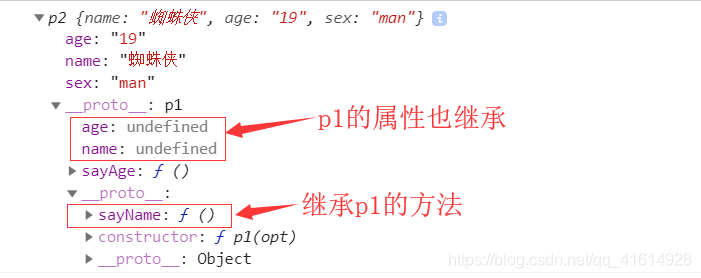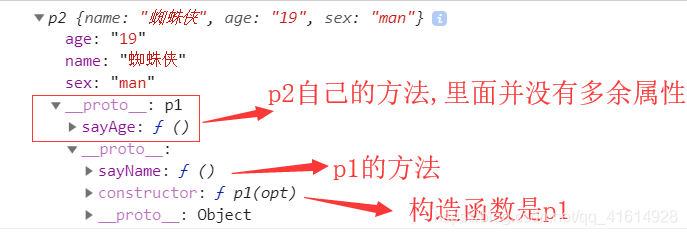<!DOCTYPE html>
< htmllang = " en" > < head> < metacharset = " UTF-8" > < title> </ title> </ head> < body> < script>
function p1 ( opt) {
this . name = opt. name
this . age = opt. age
}
p1. prototype. sayName = function ( ) {
console. log ( this . name)
}
function p2 ( opt) {
p1. call ( this , opt)
this . sex = opt. sex
}
p2. prototype = p1. prototype
p2. prototype. sayAge = function ( ) {
console. log ( this . age)
}
const o2= new p2 ( {
name: "蜘蛛侠" ,
age: "19" ,
sex: "man"
} )
console. log ( o2)
</ script> </ body> </ html>
<!DOCTYPE html>
< htmllang = " en" > < head> < metacharset = " UTF-8" > < title> </ title> </ head> < body> < script>
function p1 ( opt) {
this . name = opt. name
this . age = opt. age
}
p1. prototype. sayName = function ( ) {
console. log ( this . name)
}
function p2 ( opt) {
p1. call ( this , opt)
this . sex = opt. sex
}
p2. prototype = new p1 ( { } )
p2. prototype. sayAge = function ( ) {
console. log ( this . age)
}
const o2= new p2 ( {
name: "蜘蛛侠" ,
age: "19" ,
sex: "man"
} )
console. log ( o2)
</ script> </ body> </ html>
<!DOCTYPE html>
< htmllang = " en" > < head> < metacharset = " UTF-8" > < title> </ title> </ head> < body> < script>
function p1 ( opt) {
this . name = opt. name
this . age = opt. age
}
p1. prototype. sayName = function ( ) {
console. log ( this . name)
}
function p2 ( opt) {
p1. call ( this , opt)
this . sex = opt. sex
}
function c ( ) { }
c. prototype = p1. prototype
p2. prototype = new c ( )
p2. prototype. sayAge = function ( ) {
console. log ( this . age)
}
const o2= new p2 ( {
name: "蜘蛛侠" ,
age: "19" ,
sex: "man"
} )
console. log ( o2)
</ script> </ body> </ html>
<!DOCTYPE html>
< htmllang = " en" > < head> < metacharset = " UTF-8" > < title> </ title> </ head> < body> < script>
function p1 ( opt) {
this . name = opt. name
this . age = opt. age
}
p1. prototype. sayName = function ( ) {
console. log ( this . name)
}
function p2 ( opt) {
p1. call ( this , opt)
this . sex = opt. sex
}
for ( var key in p1. prototype) {
p2. prototype[ key] = p1. prototype[ key]
}
p2. prototype. sayAge = function ( ) {
console. log ( this . age)
}
const o2= new p2 ( {
name: "蜘蛛侠" ,
age: "19" ,
sex: "man"
} )
console. log ( o2)
</ script> </ body> </ html>









 博客介绍了JavaScript中四种原型继承方法。方法一是直接prototype等号赋值,但存在地址相同问题;方法二是B.prototype = new A({}),会将函数与声明变量都赋值;方法三结合前两者优点;方法四遍历需继承方法的prototype,但无法继承.prototype.prototype。
博客介绍了JavaScript中四种原型继承方法。方法一是直接prototype等号赋值,但存在地址相同问题;方法二是B.prototype = new A({}),会将函数与声明变量都赋值;方法三结合前两者优点;方法四遍历需继承方法的prototype,但无法继承.prototype.prototype。
















 1478
1478

 被折叠的 条评论
为什么被折叠?
被折叠的 条评论
为什么被折叠?








